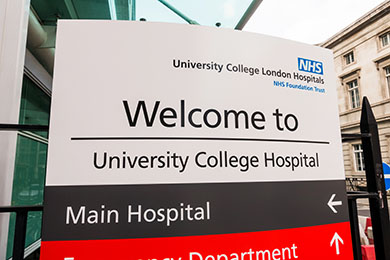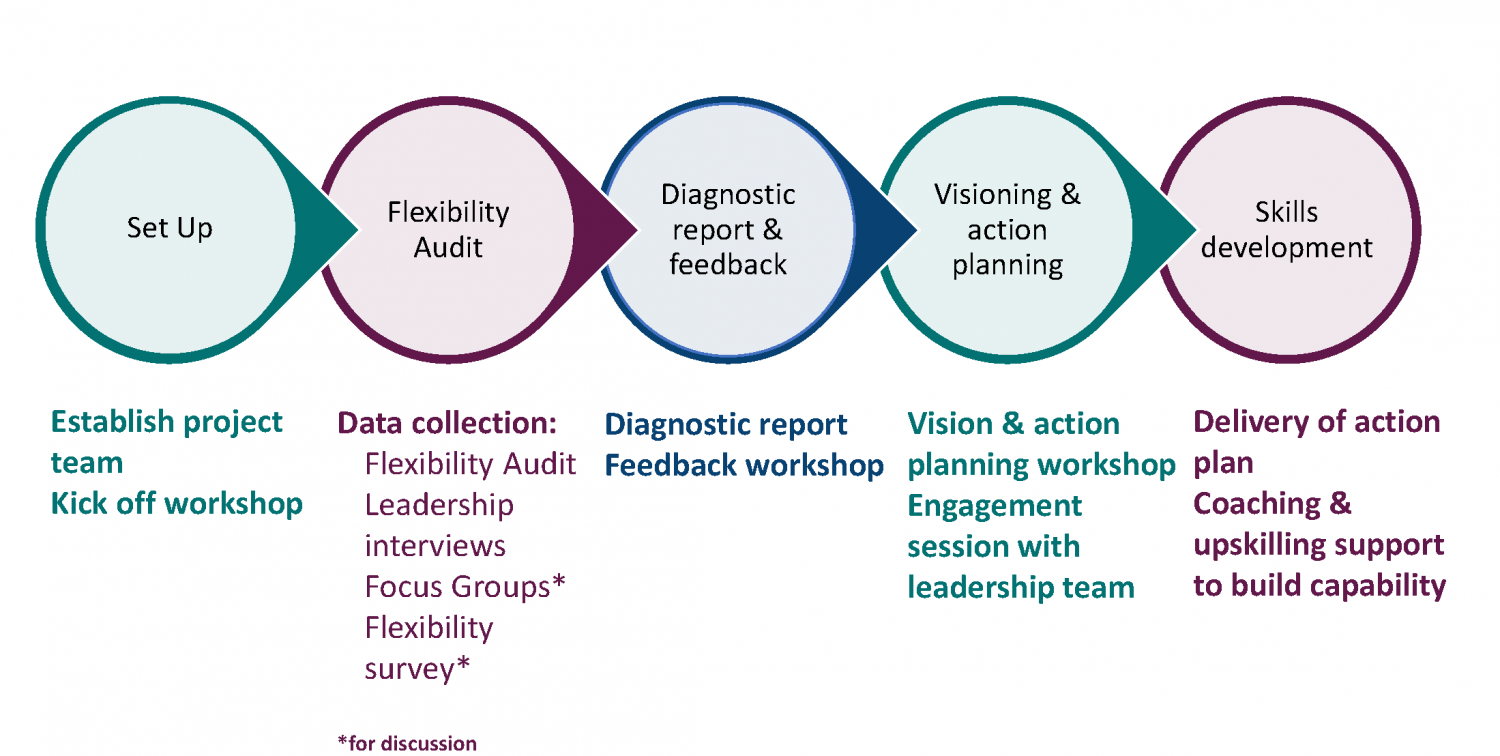

University College London Hospitals NHS Foundation Trust (UCLH) had already brought in remote and hybrid working for office-based staff and were keen to offer flexibility to other areas as well, giving ward-based staff more control over their working patterns. Here’s how we supported them to successfully pilot self-rostering for 152 staff across four wards, and then roll out to nursing staff across the Trust.

UCLH is a large teaching hospital, part of the Shelford Group, which has over 10,000 staff working across 10 London sites. The leadership team is keen to create a work environment in which staff feel valued, encouraged and supported, and as part of this, has sought to explore how to improve work-life balance.
Like many organisations, UCLH implemented remote and hybrid working for office-based staff during and after the pandemic. However, there are unique operational constraints in some patient-facing and clinical areas, mainly wards and teams delivering 24-hour services. Hybrid working was not a viable flexible working option for ward staff and the leadership team felt it was important to find other ways to offer flexibility for these teams. This was reinforced by a survey in 2021, which revealed that 51% of staff felt they had a good balance between work and home life, and just 48% felt that UCLH was committed to helping them balance these two elements.
Following this feedback, UCLH launched a new flexible working policy in 2022, which offered a more proactive approach to flexible working. This included the implementation of a new electronic rostering system, which in turn opened up opportunities to explore innovative approaches for ward-based staff.
However, the team felt they needed to bolster local resources with dedicated external expertise to drive the project forward, including the support of someone with experience in delivery. A member of UCLH worked with Timewise on a previous project at another NHS Trust and approached us to provide support for the self-rostering project.
Our team worked with UCLH to pilot a self-rostering approach, which allows staff to select their preferred shift arrangements and days off. These requests build a draft roster, which is then reviewed and adjusted (if necessary) by the ward manager / senior nurse. On completion the roster is 1st level approved by the ward manager followed by a 2nd level approval by the matron. It gives staff more input and control into the shifts they work, and makes the rostering process easier, and quicker, for the ward managers.
We agreed to pilot this approach with four wards of varying sizes, which were spread across two sites, and represented different clinical divisions and ward size. Approximately 152 staff were involved.
Working closely with the UCLH team, an integrated project team was created. We began with a research phase that looked at existing workforce data, and explored how the staff on the four wards were currently using the system. We then brought representatives from each ward together to work with us to design the pilot, setting out the principles and etiquette that would allow self-rostering to run smoothly.
We also sought to engage directly with the ward managers and matrons from each ward, knowing that they would be responsible for managing the new roster on a day-to-day basis, and for fielding questions about how to use it. And we created a range of resources for the UCLH intranet, which set out the parameters of the project, explained how to use the roster and answered common questions.
Having sought to get everyone on board, we then ran the pilot across the four wards for three months. Feedback was gathered through ward visits and surveys, and fed into a formal evaluation of the pilot, which could be used to steer a potential wider rollout.
We identified potential challenges before we began the pilot, such as the technology limitations, and the ‘first-come-first-served’ nature of the system being potentially contentious. However, the roster team provided the necessary training to ensure the rostering technology could be used effectively. The project team presented and communicated clearly the ‘etiquette’ involved in this new approach to rostering – encouraging staff to consider the impact of the shifts they were selecting on the wider team, by drawing on the Trust values. This helped mitigate these potential problems, none of which turned out to be issues during the pilot itself.
We did encounter some implementation challenges as the pilot developed. For example, although self-rostering should be used to book shifts or days off, some staff began using their allocations as a way to book time off work, instead of going through the annual leave process. Similarly, while each shift needed a senior nurse to select the nurse in charge shift some staff were not booking into these shifts. This impacted the overall shape of the roster and so the issues were addressed, and both of these were quickly overcome through conversations at a local level.
In terms of outcomes, we sought to evaluate how many staff were using the new roster approach to input their preferred shifts, and how many were approved. By the end of the pilot:
Critically, this new way of rostering was used by all staff groups, though slightly less by the unregistered staff. Positively, the ward managers reported they saved time, due to a large proportion of the roster already being populated before they got involved and had fewer swap shift requests after roster publication.
The UCLH team provided a detailed evaluation of the pilot, and approval was obtained to rollout self rostering across the nursing teams within the Trust.
Following the successful pilot, self rostering has been rolled out to the nursing teams in a further 43 wards across two hospital sites. The only exceptions are the emergency and critical care units (three wards) who had recently established their own specialist rostering arrangements including rolling rosters.
In order to enable roll out at this scale, the 43 wards were grouped into six cohorts, who went live with self rostering in a phased pattern across a period of six months. Timewise supported the UCLH project team and steering group to agree the roll out approach, standardise roster rules and get the engagement, training and comms right, building on our learning from the pilot. A valuable addition for the roll out was the appointment of a ward advocate for each ward, whose role was to support the project team and the ward managers by liaising with nursing colleagues, ensuring people understood the new approach, and flagging any issues or concerns early so that the roll out could progress smoothly. The steering group met monthly to monitor progress, measuring take-up and approval rates and ensuring they were in line with the high levels achieved in the pilot.
The nursing roll out is now complete, and some non-nursing teams across the Trust are starting to express interest in this way of working and exploring the benefits it could have for them also – watch this space!
Claire Stranack, HR Business Partner at UCLH, has this advice for anyone considering a similar project:
Inge Cordner, Lead Nurse for Nursing & Midwifery Workforce, has some additional suggestions from the frontline:
Timewise brought a huge amount of experience and resources and supported us at every stage of the process. They acted as a critical friend, supporting and facilitating design and engagement sessions, and driving the project forward at a pace we could not have achieved alone. There is no way we could have delivered this pilot within this timescale without Timewise’s involvement.
Claire Stranack, Human Resources Business Partner at UCLH
Often working in the NHS we have so many competing priorities that you can often be pulled in many directions. Someone outside of that space, supporting with external expertise, as provided by Timewise, meant we were able to hit the ground running whilst being able to build our own organisational knowledge at the same time. The project was well managed and enabled us to use our time efficiently. Thank you, Amy!
Inge Cordner, Lead Nurse for Nursing & Midwifery Workforce, UCLH
Published June 2024, updated May 2025

Michelmores, an all-services law firm with 450 staff and offices in Exeter, Bristol, London and Cheltenham offers agile working (a combination of working in office and at home) to all staff, where possible in the role. Prior to the pandemic, Michelmores had many individual flexible arrangements and sought to accommodate staff requests when possible.
During the pandemic, during which almost all of Michelmores’ staff worked from home, HR and the senior partners foresaw that they would need to re-imagine the workplace once the return-to-office started. It was difficult to know what the range of options should be and to anticipate their implications. They wanted support in developing new ways of working and to engage staff in the process.
Michelmores came to Timewise looking for an expert view, the wider context of what was happening in the greater labour market and thoughts on how to plan ahead. Colette Stevens, HR Director at Michelmores, says: “Timewise have a real depth of understanding of all the different flexible working options, what the implications would be of pursuing them and a strong commitment to understanding Michelmores’ needs, context and ambitions. Timewise gave us a framework and process within which to explore ideas, challenge thinking and think about different options.”
Timewise convened a working group, made up of Michelmores’ Managing Partner Tim Richards, HR Director Colette Stevens and other senior partners. This team developed the firm’s Agile Working framework with Timewise’s input and guidance. Fairness sits as a core principle within this framework: the goal is to provide all employees with the opportunity to balance working from home and in the office, as agreed within their teams. The framework provides a practical structure, as to the ‘how’. By way of guiding values, the group wanted to ensure that:
Team leaders were tasked with helping to identify any underlying issues and collaboratively working through the implications of agile working in detail with their teams. The agreed framework was rolled out for a year-long trial, with regular feedback from staff at all levels.
Recognising the critical role of managers, Timewise ran bespoke training sessions to help them feel capable and confident in implementing the agile working framework for their teams. Timewise then worked closely with the project team to facilitate follow up review sessions a few months into the trial, for managers to share good practice, seek support and ask questions.
The agile working approach adopted by Michelmores has been a great success, with over 80% of staff expressing satisfaction with how they can work, giving them greater choice and freedom. Set this against the wider context of the pandemic’s impact upon the legal profession. A 2021 study by Gartner of 202 corporate lawyers found 68% were ready to start looking for a new job.
Michelmores prides itself upon enhanced talent attraction. It now offers a more flexible approach than many other law firms, and this is having an impact on its reputation as a great employer. As one recent joiner comments: “The flexibility offered was a huge factor in my decision to join Michelmores. My previous firm wanted fixed three days in the office, and my commute is long.”
It has also created the opportunity to attract candidates from a wider geographical area than before. Another new joiner says: “…being sure agile worked in practice was my first question. It meant I could join and not have to relocate.”
Michelmores continues to monitor and evolve its agile working approach, including understanding the impact on new joiners such as these and developing induction and onboarding processes to suit new ways of working. Valuing the different office sites and bringing people together in person continue to be important for the organisation as it grows. Working in an agile way encourages teams to use office time more intentionally and the Michelmores agile working approach, with the flexibility that it brings, is now firmly part of the organisational culture.
Colette Stevens, HR Director of Michelmores, summarises: “Timewise really listened to what we were grappling with and what was important for us. They helped us co-curate our approach to agile working and differentiate what we can offer the market.”
Published January 2024

By Amy Butterworth, Head of Consultancy, Timewise
It’s no secret that retail is a tough nut to crack when it comes to flexible working. The industry is the UK’s largest private sector employer, with around 5 million people in its workforce. But while some roles, such as sales assistants and head office staff, tend to allow for some part-time and flexible working, there’s a real lack of these opportunities within retail management. And that, in turn, is having a knock-on effect on companies’ ability to attract and keep staff.
So it’s pretty big news that Wickes, the home improvement retailer, is committing to making all roles open to flexible working, from the point of hire. What’s driving this decision? And how can they be so sure that it’s the right one? The answer – because they are passionate about creating a workplace culture where all colleagues can feel at home and thrive and because they’ve worked with us to explore the art of the possible and test it out.
While Wickes have had real success in making entry-level in-store roles more flexible, they had become aware that access to flexible management roles was very limited, and that their managers were finding it challenging to fit their responsibilities into their allocated hours. So before approaching us for support, they did some digging to try and find out why.
The process saw them interrogate the responsibilities of three management roles: store managers, operations managers and duty managers. This revealed occasional confusion about who should be doing what, which in turn was limiting the managers’ efficiency and effectiveness. It also highlighted that some managers felt a responsibility to be in-store that didn’t necessarily match service needs.
Mark Reynolds is Store Manager of Wickes in Tottenham. He says:
“Before the trial I was probably doing five long days in store. I remember having my review. I’d just won Store Manger of the Year. But my home life wasn’t great. My daughter was 3.5 and my other was newborn.”
“I’m a self-confessed workaholic, and put in all the hours I can. But I had started to realise that a change was needed. I wasn’t getting any time at home with my wife. She was getting no support from me. And I had started to drift from my friends, who always get together at weekends (when I used always to be working).”
Tanya Tozer works in the Worksop store. She has 3 children – all girls, aged 5, 9 and 12. Her middle daughter, Ava-May, has a rare genetic condition called De Grouchy syndrome which requires a lot of support at home. She says: “I didn’t think I needed to change my working pattern, but on reflection, I needed the respite more than I let on, more probably than even I realised I needed it. I had been struggling with my mental health.”
So, building on our many years of experience, we worked with the Wickes team to design, trial and evaluate a six-month pilot across 14 Wickes stores. This saw us supporting the managers to redesign their working patterns, with some opting to work four longer days in-store, and others flexing their hours across the week in a way that suited their lives.
They also kept a reflective diary to track their working hours, and identify why they might be working more than they should. And they were supported by us, and each other, with monthly feedback and learning calls.
As always with our pilots, we put in place a robust system of tracking and evaluation so we could really understand what worked and why. From this, we gained some valuable learnings, including:
The pilot also busted the long-held myth that managers need to be on-site at all hours, and highlighted the fact that when managers step back, they create space for their junior colleagues to step up.
There was no negative impact on store performance or KPIs, and the feedback we received from the pilot participants speaks for itself; 96.5% of store managers were either ‘satisfied’ or ‘very satisfied’ with their work-life balance at the end of the pilot (up from 66.5% pre-pilot).
But perhaps the best way to demonstrate the impact of the pilot is to hear from the people involved.
Tanya says the change to her working pattern, has changed her life: “Now, I can go to the gym, I can do some crafting. I have always had Tuesdays off, as these tend to be hospital days. But having Fridays off is really making a difference in my life. The girls are in school. It is my day for me.”
And it has also helped her team: “I think it’s had a really positive impact on the team. It has helped everyone feel more accountable. I’ve had to strengthen some of my weaker areas; build in more planning and more structure. I’ve also had to delegate more and it has been great to see the team step up to the challenge and grow.”
And here’s Mark again, on how this different way of working has affected him personally:
“At first, I felt a lot of guilt and responsibility. But gradually I realised – it was just about setting a new norm. Getting the processes in place was not easy, but once you get there – it’s a different way to live and work. A better one. I’ve developed a new phrase: happy home life, happy work life. I am a happier me.”
He’s also clear about the effect he believes it will have on the future of Wickes, and the retail industry as a whole:
“We have a WhatsApp group called Trailblazers – we all believe we are part of shaping the next generation. We feel part of something special. At the moment I am looking at ways to retain colleagues who are mothers, and possibly help them onto the management track. Make one small change and a thousand more will follow… people will stay and build their careers as their lives change. I don’t see any negatives whatsoever.”
Unsurprisingly, given the pilot’s success, Wickes are now rolling it out across all stores to more roles, those of duty manager and operations manager. They’re doing so as part of our wider Flexible Working for All action research programme, supported by Impact on Urban Health, with Guys’ and St Thomas’ NHS Foundation Trust and Sir Robert McAlpine also taking part, which aims to show the impact of embedding good quality flexible working for all on both employees and organisations.
And as Louise Tait, Wickes’ Head of HR, OD and Talent noted when she appeared as a panellist at a Timewise webinar, there’s a hope within Wickes that the retail industry will have a mindset shift and start asking “What’s the right thing to do” when it comes to offering flexible working. With this kind of evidence of the power of flex to change companies’ cultures and people’s lives, why wouldn’t they?
Published January 2024

GRAHAM is a privately owned Construction and Facilities management company with 16 regional offices throughout the UK and Ireland, with 2,500 staff. Its Civil Engineering division specialises in resolving complex engineering challenges, from easing commuter congestion to powering renewable energy.
The challenge and opportunity
GRAHAM’s workforce already had a degree of informal flexible working and, having read our report – Making construction a great place to work – wanted to understand how to extend this further to all teams through engaging the site-based managers. Recognising the shift in expectations for more agile working, and understanding that it would be key to staff retention and recruitment, GRAHAM’s leaders were keen to bring about change as quickly as possible.
In the past, objections to introducing flexible working practices within the construction industry have centred around the need to maintain health and safety standards, being unable to offer any level flex to all roles, meeting commercial targets and managing sub-contractors and suppliers.
“The construction industry is very traditional in its approach to working, but we want to challenge this and demonstrate that flexibility can be integrated without compromising on delivery for clients or financial performance.” Michael Smyth, HR Director GRAHAM Group
Our solution
While there was broad enthusiasm for change across the organisation, there were some initial pockets of reluctance, largely due to a concern that there was already enough to do without having to manage new working patterns. Our position as external experts, and collaborative approach, were considered key to overcoming this barrier.
Working closely with the GRAHAM Human Resources team, we explored two options; running an in-depth pilot program with a small part of the business, or providing training and support for managers more broadly across the Civil Engineering division, so they could initiate their own flexible working pilots.
We concluded that the best route was to implement a top-down approach by engaging the team managers. This would allow them to adapt their learnings to their own teams’ circumstances and overall objectives.
“In order to fast track the benefits of more agile working patterns, we partnered with Timewise. Their consultants took the time to understand our objectives, working with us to develop an adaptable model that fitted with our business needs, but which was also easy to implement for managers on the ground.” Michael Smyth, HR Director GRAHAM Group
The process
We began by designing a series of regional workshops for site-based managers, to share real-life examples of how flexible working can be successfully implemented for construction workers.
As well as sharing our experience and expertise from our work elsewhere in the sector, we also highlighted examples of where flexibility was already taking place informally at GRAHAM. Sharing these examples helped bring the discussions to life, highlighting arrangements that were working well and opening up conversations about how to build on them.
The rate of change in attitudes towards flexible and hybrid working within the industry has outstripped that of many team managers, so hearing relevant success stories from colleagues, as well as our third-party expertise, was key to opening minds to the potential benefits.
Overall, the workshops demonstrated clearly that, despite people’s fears that working flexibly might negatively impact the project, it actually benefitted it, by helping workers become more engaged and productive.
Learnings and outcomes
The workshops really helped overcome negative preconceptions of flexible working, with the majority of attendees immediately seeing the value of offering it to their teams and understanding how even small changes can make a big difference to individuals.
At the end of each workshop, all attendees agreed to commit to doing at least one thing to work towards implementing flexible working in their own teams. To support this, this, we also built guidelines for Civil Engineering managers to use on site as they evolved their ways of working. This was all brought to life with anecdotes from our previous pilot work within the sector.
GRAHAM continues to review their operations, collating their learnings for ongoing review. This will help managers to see the value of flexibility, which has already resulted in lower staff turnover and increased engagement rates.
The client’s view
“We are an innovative employer and recognise that creating a modern working environment leads to personal and business benefits. Timewise’s holistic approach means ongoing support beyond the project with access to their peer community. Creating change won’t happen overnight but with the ongoing support, innovation and advice from Timewise, a modern working culture will emerge.” Michael Smyth, HR Director GRAHAM Group
Published January 2023
The whole thing about flexibility is that it’s a big cultural change so it isn’t going to happen overnight. It’s all about supporting line managers with their decision making and widening out people’s vision so they’re not just saying, ‘No, that’s not going to work’
Fran Wilson
Lead Nurse for Attraction, Recruitment & Retention
Gloucestershire Hospitals NHS Foundation Trust

Government of Jersey (GoJ) is a complex and multi-faceted organisation which employs around circa 7,000 employees. Their roles span all central government departments and the delivery of all key public services, including prison, uniformed services, police, education, health, and social care.
The challenge and opportunity
Prior to the Covid-19 pandemic, GoJ were already looking to develop a more systemic approach to flexible working, as a way to improve diversity (particularly gender diversity at senior levels) and to tackle recruitment and retention. The pandemic then acted as a catalyst for increasing flexibility within the organisation, and helped encourage leadership buy-in for making the change.
“Our staff survey responses provided a strong signal that the flexibility employees had experienced during the pandemic was something they wanted to retain and build upon. During the pandemic, many people had gone the extra mile and flexed how they work for the benefit of the organisation and the island. We were particularly conscious of how demotivating it would be for our workforce if we ignored their feedback and simply reverted to old ways of working.”
The Timewise Flex Positive Programme
We agreed with GoJ that our Flex Positive Programme would be the best route to developing a systemic approach to flexible working.
The programme includes an organisation-wide diagnostic to understand the status quo and identify opportunities to enhance flexibility, and workshops to support the development of an organisational vision for flex. These feed into the development of a flex action plan, which is followed by skills development workshops, focusing on job design and creating a culture of flexibility.

“The benchmarking / diagnostic process was really good for us, giving us an independent review of our working practices and helping us see what good looks like. Through the programme, Timewise provided us with a clear roadmap and introduced us to the concept of taking a team-based approach. It helped us to focus on what was important and create an action plan which didn’t seem overwhelming. Timewise bring a wealth of experience and understand what works – without their expertise and guidance it would have taken us a lot longer to make the change.”
Flexible working pilots
We also worked with GoJ to design and deliver flexible working pilots within four departments. These ran between September 2021 and January 2022, supported by monthly coaching clinics led by our team.
At the end of each pilot, we carried out evaluation surveys to gather feedback from participants, to understand their experiences of working flexibly and identify any areas in which they felt flexibility could be further enhanced.
“The pilots have generated learning which has moved the organisation further forward and encouraged others to consider and rethink their approach.”
Key learnings from the programme included:
Trust and an open mindset are critical to success. Start from a place of trust and empower people to balance their needs with the needs of their jobs / team / stakeholders and customers.
A consistent approach from line managers is critical. Upskill line managers across the organisation in flexible job design, managing flexible teams and building trust, to ensure a consistent approach.
“You have to get the managers on board and change their mindsets around flex – if you don’t do that it won’t work. Give them the skills and confidence to take it forward.”
Take a team-based approach. Develop flexible working on a whole-team level so that employees take collective responsibility for ensuring a fair approach. Seek feedback regularly and work together to find solutions to any challenges that may arise.
“We learnt how critical taking a team-based approach is – involve everyone and be open and transparent in discussions you have.”
Learn and evolve. Be willing to experiment; be creative and open-minded about the parameters for pilots, using job design methodology to explore what is possible for each role. Share the experiences of pilot departments with other teams to showcase what is possible, and help to build a culture of flexibility across the wider organisation.
“With pilots, you don’t necessarily get an outcome which will be right first time. It is an iterative process and provides vital learning which helps you evolve and become more creative.”
“We have created a momentum and there is no going back now! We have adopted a more organic approach to flex as an organisation, the conversation is happening now, and flex has become a leadership priority.”
GoJ now proactively promote all jobs as being open to flexibility, both internally and to potential applicants. They are implementing their flex action plan, have delivered training to managers, and developed toolkits and guidance. Flex is now firmly on the leadership agenda.
Through the pilots, they have been able to develop case studies and showcase what is possible to other teams (including flex in senior roles). And, using a team-based approach, they are now rolling out further pilots across other departments.
The feedback we received from pilot participants speaks for itself. On average:
The client’s view:
“I would highly recommend working with Timewise. They bring a breadth and depth of experience which was invaluable, but what I have valued above everything else has been their flexibility and support. They truly operated as a trusted partner and were always there for us, we never felt left to get on with it. They were as committed, passionate and connected to the outcome as we are.”
Published June 2022